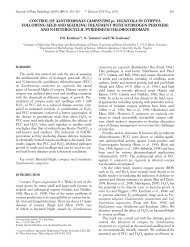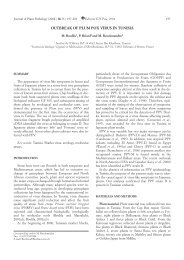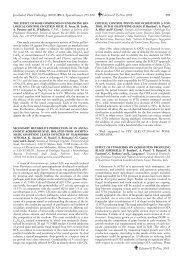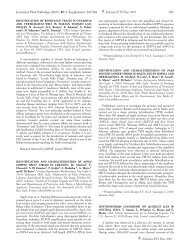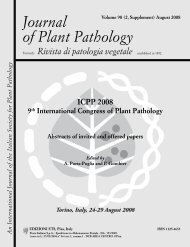Journal of Plant Pathology (2010), 92 (4, Supplement ... - Sipav.org
Journal of Plant Pathology (2010), 92 (4, Supplement ... - Sipav.org
Journal of Plant Pathology (2010), 92 (4, Supplement ... - Sipav.org
You also want an ePaper? Increase the reach of your titles
YUMPU automatically turns print PDFs into web optimized ePapers that Google loves.
<strong>Journal</strong> <strong>of</strong> <strong>Plant</strong> <strong>Pathology</strong> (<strong>2010</strong>), <strong>92</strong> (4, <strong>Supplement</strong>), S4.71-S4.105 S4.103<br />
tique et Ecophysiologie de la Qualite des Agrumes–GEQA, INRA,<br />
Route de l’INRA, San Giuliano-Corse, France. 3 Dipartimento di<br />
Scienze Entomologiche, Fitopatologiche, Microbiologiche, Agrarie e<br />
Zootecniche, Sezione di Patologia Vegetale e Microbiologia Agraria,<br />
Università degli Studi, Viale delle Scienze, 90128 Palermo, Italy. Email:<br />
mtessitori@unict.it<br />
Tristeza disease, caused by Citrus tristeza virus (CTV), is the<br />
one <strong>of</strong> the most important viral diseases <strong>of</strong> citrus species. Several<br />
strains <strong>of</strong> CTV have been studied all over the world. Two isolates<br />
have been previously identified in Corsica, the K strain from<br />
Marumi kumquat, known to determine no symptoms on Mexican<br />
lime, and the Cal-1 from calamondin that induces stem pitting on<br />
the same indicator. Few sequence data <strong>of</strong> both isolates are published<br />
or available in GenBank. Recently additional CTV strains<br />
were found in Corsica. The isolates LA5 and CO3 were detected<br />
in two different 40-year-old orchards <strong>of</strong> Clementine on sour orange<br />
that did not show decline or other tristeza symptoms. CTV<br />
was identified in young shoots collected in the field by RT-PCR<br />
using primers specific for the p20 and p23 proteins. The amplicons<br />
obtained were analyzed by SSCP, cloning and sequencing.<br />
Both CTV isolates showed the same SSCP patterns for both proteins<br />
which differed from control patterns (DS1, DS2 and T36).<br />
Sequences analysis diclosed a high similarity between the two isolates<br />
(98%) for both p20 and p23. Multiple alignment analysis <strong>of</strong><br />
LA5 and CO3 showed a similarity <strong>of</strong> 98% with CTV isolates deposited<br />
in GenBank. Moreover, with respect to the already described<br />
groups <strong>of</strong> CTV isolates, mild, severe and atypical, phylogenetic<br />
analysis revealed a new cluster that includes both LA5<br />
and CO3 isolates<br />
SYNERGISTIC INTERACTION BETWEEN POTATO<br />
SPINDLE TUBER VIROID AND CUCUMBER MOSAIC<br />
VIRUS IN TOMATO. E.M. Torchetti, B. Navarro, F. Cillo, F.<br />
Di Serio. Istituto di Virologia Vegetale del CNR, Via Amendola<br />
165/A, 70126 Bari, Italy. E-mail: em.torchetti@ba.ivv.cnr.it<br />
Potato spindle tuber viroid (PSTVd), a nuclear replicating viroid<br />
included in the EPPO A2 list <strong>of</strong> quarantine pests, causes severe<br />
diseases to potato and tomato. In the last few years, this viroid<br />
has been detected in several symptomless ornamental solanaceous<br />
species in many European countries, producing a general<br />
alert on the risk <strong>of</strong> possible PSTVd outbreaks in horticultural<br />
crops. The recent report <strong>of</strong> symptomatic tomato plants infected<br />
by PSTVd in Italy has increased such concerns. Since tomato is<br />
also a natural host <strong>of</strong> Cucumber mosaic virus (CMV), its response<br />
to mixed infections by this virus and PSTVd was investigated.<br />
Here, we report the synergistic interaction <strong>of</strong> contemporary infections<br />
by a mild strain <strong>of</strong> PSTVd and the Fny strain <strong>of</strong> CMV in<br />
tomato cvs. Micro-Tom and UC82. <strong>Plant</strong>s infected by both<br />
pathogens showed severe stunting, delay <strong>of</strong> flowering, and frequent<br />
systemic necrotic lesions that completely impaired plant<br />
growth. These symptoms were never observed in PSTVd and<br />
CMV single-infected plants, which only showed slight stunting<br />
and leaf deformation, respectively. Data about the accumulation<br />
levels <strong>of</strong> each pathogen in single- and mix-infected hosts will be<br />
discussed in the context <strong>of</strong> a possible role <strong>of</strong> RNA silencing in the<br />
synergistic interaction. These findings highlight the need <strong>of</strong> implementing<br />
control measures to restrain PSTVd spread in Europe.<br />
ALTERNARIA LEAF SPOT ON OKRA IN TANZANIA:<br />
PROSPECTS FOR BIOLOGICAL CONTROL IN SUSTAIN-<br />
ABLE AGRICULTURE. E. Turco 1 , M. Galla 2 , D. Bocciolini 3 , S.<br />
T<strong>of</strong>ani 3 , A. Ragazzi 2 . 1 Istituto per la Protezione delle Piante del<br />
CNR, Via Madonna del Piano 10, 50019 Sesto Fiorentino (FI),<br />
Italy. 2 Dipartimento di Biotecnologie Agrarie, Sezione di Protezione<br />
delle Piante, Università degli Studi, Piazzale delle Cascine<br />
28, 50144 Firenze, Italy. 3 Cooperativa Agricola di Legnaia, Via di<br />
Sollicciano 13a, 50142 Firenze. E-mail: e.turco@ipp.cnr.it<br />
The “Progetto Tanzania” was funded in 2006 by the Cooperativa<br />
Agricola di Legnaia, the oldest and largest agricultural cooperative<br />
in Tuscany. In 2007, the Faculty <strong>of</strong> Agriculture <strong>of</strong> the Universisity<br />
<strong>of</strong> Florence joined the project. Besides the humanitarian<br />
and economical assistance to “Villaggio della Speranza” in<br />
Dodoma and San Gaspare hospital in Itigi, the project is involved<br />
in improving and upgrade livestock and crop plants (mainly vegetables)<br />
<strong>of</strong> local communities. Okra (Abelmoschus esculentus L.) ,<br />
a traditional food plant in Africa with a high nutritive value, is essential<br />
to the daily diet <strong>of</strong> local population, consisting almost exclusively<br />
<strong>of</strong> carbohydrates. Eco-compatible measures to control<br />
and eradicate fungal diseases are therefore required to manage<br />
sustainable agriculture and rural development. Periodical surveys<br />
<strong>of</strong> the health status <strong>of</strong> okra plantations in the area <strong>of</strong> Itigi (Manyoni<br />
discrict, 5°42’S 34°29’E, 1300 m a.s.l.) revealed leaf spots and<br />
blight caused by Alternaria alternata. The biological control <strong>of</strong><br />
the disease by the application <strong>of</strong> Trichoderma viride and Epicoccum<br />
nigrum is the scope <strong>of</strong> this report. Field experiments were<br />
carried out during the rainy season <strong>of</strong> 2009. Leaf spots and<br />
blight, before and after treatment with the two fungal antagonists,<br />
were scored and DI (disease score index) using a three class<br />
scale was assessed over 8 weeks. DI above 2 was observed starting<br />
6 weeks after pathogen inoculation. Leaf symptoms caused by<br />
A. alternata were not significantly reduced by the presence <strong>of</strong> either<br />
T. viride or E. nigrum. The efficacy <strong>of</strong> fungal antagonists and<br />
validity <strong>of</strong> the experimental protocol are discussed in relation to<br />
the environmental and climatic conditions.<br />
PRELIMINARY RESULTS ON THE EFFECT OF GOSSY-<br />
POL ON FEW AUSTRALIAN FUSARIUM OXYSPORUM f.<br />
sp. VASINFECTUM ISOLATES. E. Turco 1 , A. Ragazzi 2 , B.<br />
Wang 3 , C.L. Brubaker 4 . 1 Istituto per la Protezione delle Piante del<br />
CNR, Via Madonna del Piano 10, 50019 Sesto Fiorentino (FI), Italy.<br />
2 Dipartimento di Biotecnologie Agrarie, Sezione di Protezione delle<br />
Piante, Università degli Studi, Piazzale delle Cascine 28, 50144<br />
Firenze, Italy. 3 Centre for <strong>Plant</strong> Biodiversity Research, CSIRO <strong>Plant</strong><br />
Industry, Clunies Ross Street and Barry Drive, GPO Box 1600, Canberra<br />
ACT 2601, Australia. 4 Bayer CropScience, Technologiepark 38,<br />
B-9052, Gent, Belgium. E-mail: e.turco@ipp.cnr.it<br />
The Australian cotton industry is an important component <strong>of</strong><br />
the Australian economy. Researchers and farmers are working to<br />
build sustainable production based on new cotton cultivars with<br />
high fibre quality and yield coupled with improved pest and disease<br />
resistance. Fusarium wilt <strong>of</strong> cotton (caused by Fusarium oxysporum<br />
f.sp. vasinfectum or FOV) appeared unexpectedly in Australia<br />
in 1995 and represents a considerable threat to the sustainability<br />
<strong>of</strong> cotton production. Therefore, considerable efforts are<br />
directed toward developing and obtaining new cotton varieties<br />
with enhanced levels <strong>of</strong> FOV tolerance. In some breeding programs<br />
attention as turned to native Australian Gossypium species<br />
with variable concentrations <strong>of</strong> gossypol, a terpenoid aldehyde<br />
with a suspected potential to improve resistance to Fusarium wilt<br />
in cotton cultivars. Because the Australian FOV isolates are genetically<br />
distinct from FOV isolates found outside Australia and the<br />
probable co-evolution pathogen and wild cotton cultivars, the susceptibility<br />
<strong>of</strong> FOV conidia to varying levels <strong>of</strong> gossypol was deter-



